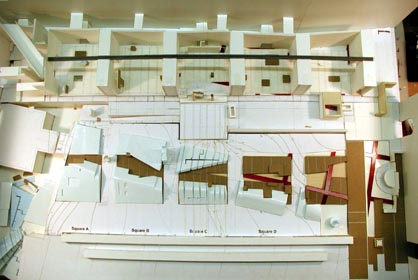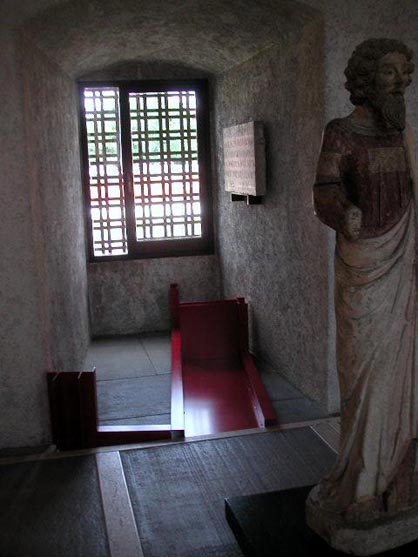| [in
italiano] |
|
The
year 1978 was one of crisis both for architecture and for Peter Eisenman.
The postmodern movement in architecture, based on a cultural approach
that would soon become laden with historicism, was increasingly taking
shape on the international scene. In Italy, where little architecture
was being done, or had been done, a few post offices with arches and
columns, and a Hollywood-style scenario with half-busts in plaster
in an earthquake stricken town in the Valle del Belice, were built.
But in America, where more architecture was being constructed, there
emerged a generation of office buildings, university campuses, and
even skyscrapers that are more reminiscent of neo-Gothic film sets
than of a serious study of the environment and the city.
In
the cultural environment generated by postmodernism there were not
only formal veneers of kitsch but also serious questions, still unresolved
53 years after the Exposition des Arts Décoratifs in Paris
in 1925. There were two themes in particular: first, the need to go
beyond the modernist taboo of "pure" formal research, and
second, the awareness that architecture belongs to a specific place.
The concept of context emerged as the fundamental theme of these years:
on the one hand, because the Western city's period of expansion had
historically ended, work was directed toward the spaces between existing
buildings, and on the other, the idea of context developed an awareness
in planning of relationships to an existing environment.

In 1978 Eisenman was in crisis because postmodernism was pushing in
a direction stylistically opposed to the research he had carried out
until that time. In addition, an absolutely key work in his development
in the 1970s, House X, was not built, and instead became the subject
of extensive graphic representation. This latter development was also
due in part to an event in 1978. That year, Eisenman was asked to
participate in "Ten Projects for Venice," a planning project
organized by the Architecture Institute at the University of Venice.
The area of study was the Cannaregio, at that time run down and unused
after a formerly distinguished industrial life. Eisenman proposed
an ingenious architectural process that contained and anticipated
the main enzymes of the town plan as it was to develop over the two
subsequent decades. He used the theme of place and context as the
main thrust of his architectural reasoning but in a way that completely
abandoned the postmodern clichés of adaptation and mimesis
and moved in a more conceptual direction. Eisenman organized the Cannaregio
with a series of grids and positions that he took from a close reading
of the city and its stratifications, as well as from Le Corbusier's
Venice Hospital project. On the basis of these force lines he formulated
a grid that literally restitched the existing with the new project
and organized the spaces and buildings as if they were regulated by
a single force. Buildings (in this case, various scalings of House
XI) were placed at strategic points inside this new campo,
and a reasoning that contained the architectural idea of layering
was triggered (that is, autonomous subsystems, each equipped with
its own structure, function, and position, when laid one over the
other defined the overall project).
Eisenman's Cannaregio employed an ingenious and revolutionary technique
that used the theme of context as a catalyst of the crisis. Context
here is no longer the inspiration for historicist settings in a postmodern
style but is the source of intensive study. As was the case with old
medieval maps, which were written on by partially erasing the older
texts, Eisenman sought lost meanings and geometries that could be
used to structure the new. The context was thus seen as a palimpsest,
but it also carried a series of narrative, metaphorical messages.
Architecture also tells a story and has a presence made up of multiple
layers of meaning: past and future, geological and urban, abstract
but also subtly narrative. Cannaregio was proposed, in short, as "boring
into the future."

The strength of this approach was seen shortly after in Eisenman's
residential building for the IBA in Berlin and gradually in his subsequent
projects, as well as in the work of other architects who sensed its
strength. For example, Bernard Tschumi's plan for La Villette in Paris
combines his own research into the discontinuous movements and syncopated
editing of cinema with Eisenman's reasoning on grids and layers.

Castelvecchio today is inconceivable without Cannaregio yesterday.
In the operation Eisenman has proposed for Verona in 2004, some 26
years after the Venice project, many notable points develop this antique
path of research. Primarily, the architect chose not to celebrate
himself through an exhibition of his work but rather proposed something
both more modest and more ambitious. He is not exhibiting himself,
but his ideas. He has in fact many times said, "I want to be
remembered for my ideas." Spaces, organizations, and fragments
of projects that are indicative of his thinking (from Cannaregio to
Santiago de Compostela) emerge in sections of the plan. In Verona,
too, grids and close readings of the historic stratifications create
the structure of the new plan, but a difficult vibration, a "pure"
intuition, almost imperceptibly takes shape between the elements of
that way of working.

On the one hand, the Castelvecchio installation shows one of Eisenman's
most powerful convictions. For him, architecture is primarily a "critical
practice." Indeed, the conceptual origin of the plan lies in
an awareness of the "slightness" of the wall (decked out
in false antique in the 1920s) that separates the sequence of Scarpa's
big exhibition rooms on the ground floor from the garden. This wall
was seen by Eisenman as if it were an immaterial diaphragm, which
allows him to bring the internal rooms into contact with the same
number of external piazze-rooms he set in the garden. In
this way the five big exhibition rooms and the same number of external
piazze establish a dialogue between positive and negative.
Furthermore, a second set of piazze are oriented on the axis
of the tower and Scarpa's famous pivoted bridge, so that the two systems
intersect. A grid "found" in this suite of piazze
then appears in fragments, or spirit-sculptures, that emerge in the
thin gap between the floors and walls in Scarpa's exhibition rooms.
In this dialogue between Eisenman and Scarpa, a well-rooted "critical
architecture" is overlaid by the thin, light, but very important
network of a "poetic architecture." Eisenman chose an apparently
secondary and trivial element of Scarpa's plan: the striped lines
on the floor drawn by the Venetian architect across the visitor's
route, give a dynamic, almost syncopated rhythm to the succession
of museum events. Eisenman "felt" the essence of these white
lines on the floor: they are the idea, implicit in Scarpa, that the
museum does not finish there, enclosed in those walls, but that it
extends outside its shell, into the city, into the atmosphere, into
history. Eisenman's intelligently critical and, above all, poetically
inspired operation was to understand the profound significance of
these marks and to use them to organize the structure of his plan
in the courtyard. He uses those lines move on the plan and in the
section in order to articulate the forms of the ground, the hillocks
and the canyon that mark the thoroughfare, and at the same time to
speak to us of Scarpa, of himself and of the great possibility of
architecture in the world.
|
|
[11dec2004] |



